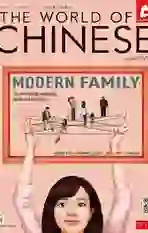SOUNDS OF A CENTURY
2018-10-20陆丹
陆丹
A singular museum in north China offers a rare insight into its musical history
在遼宁旅顺的留声机博物馆内,收藏着一段属于老馆长王心伟的音乐历史
Wang Xinwei tosses a coin into a black hat, and the hurdy-gurdy man slowly cranks into life, playing the kind of novelty song last heard on the streets of New York in the early 20th century.
But the organ grinder is an animatronic model, manufactured in the Netherlands in 1918, and the location is a museum in Lüshun, a small city at the extreme southern tip of the Liaodong Peninsula, with its own singular history.
“Lets give a cheer for these magical sounds from 100 years ago!” cries Wang, encouraging his audience of some 20 tourists, whove come from around the world to explore his phonography museum, a damp storage building that Wang, a retiree in his 60s, has converted into a unique private collection.
Dating from 1887 to 1979, over 25,000 records and antique phonographs offer a unique insight into musical and military history.
Surrounded by ocean on three sides, Lüshun was a strategic seaport in several conflicts, including the First Sino-Japanese War (where it was the site of an infamous massacre), the Russo-Japanese War of 1904, and World War II. Named Port Arthur, after Royal Navy Lieutenant William C. Arthur, who surveyed the area in 1860, Lüshun was a fortified area guarding the approach to Manchuria, and thus vital to power plays in the Far East.
Successively administered by the Russian and Japanese empires, then the Soviet Union until 1953 (its now the Lüshunkou district of Dalian), Lüshun was settled by thousands of foreigners in the early 20th century, among them merchants, diplomats, journalists, artists, and army officers. Many owned phonographs and records produced in the US, Europe, and China, considered high-end entertainment in the early 1900s.
Born in 1953, the descendant of a wealthy and music-loving Qing dynasty family, Wang remembered having a gramophone at home, which he could already take apart and put back together by age seven. After school, he would cut grass to sell for cattle feed, earning 3.7 RMB after many months—enough to buy phonograph in a pawn shop.
Since then, phonographs have never been out of Wangs life. The story of how he came by—and kept—his complete collection is remarkable.
Some records he inherited, but most he bought cheaply from his neighbors and, later, antique markets; they were left behind by Chinese and foreign families that fled the country during the events of the 20th century.
In the 1930s, Lüshun became part of Japanese-controlled Manchuria, roughly equivalent to todays Dongbei. During the occupation, Lüshuns citizens were not allowed to speak Chinese in public and forced to learn Japanese at school. Records that preserved Chinese culture, such as traditional Peking or Yue opera, were a source of comfort during those dark days of colonial oppression—although their ownership and recording was strictly controlled by the South Manchuria Railways Company.
Decades later, Wang received donations from the sons and daughters of many eyewitnesses to that dark period. “People in Old Town know all about Mr. Wang, and his good heart,” one 80-year-old visitor told TWOC. “Thats why, after my father passed away, I gave his beloved phonographs to Wang.”
During the Cultural Revolution, Wangs records faced another threat, as foreign culture was declared a form of “spiritual pollution” and considered “counterrevolutionary.” But when the Red Guards set out to “smash the olds,” as Mao had instructed in 1966, Wang had an ingenious defense.
“When [they] came to confiscate my phonographs, I told the Red Guards, ‘These magical instruments can sing Chairman Maos songs! Fortunately, the first record I picked out was ‘The East is Red,” Wang told TWOC, referring to the famous paean to Mao. Though he said hed been “breathless with anxiety,” the ruse worked—so well, in fact, that he was invited to join the Red Guards, and entrusted with the task of helping to identify, critique, and eradicate pre-Liberation phonographs from Lüshun.
Wang could scarcely believe his luck. He went about confiscating contraband vinyl, such as foreign or “feudal” music, from local residents; only instead of demolishing them, he secretly hid the records.
Although Lüshuns tragic history as a locus of siege and slaughter is an inerasable scar on 20th-century China, Wangs museum manages to evoke what warmth and culture existed during this turbulent period. For Wang, the records are “loyal witnesses” to history, and can awaken powerful memories for future generations to learn from.
Many, including the first generation of wax and lakh (or gum) records made in China in the 1900s, are highly valuable, and contain musical masterpieces from contemporaneous artists such as Tan Xinpei, Mei Lanfang, Ma Lianliang, and Zhou Xuan. Other collectors have frequently approached Wang, determined to buy them at any price, but he says he has refused to sell.
However, as a private museum, Wang must rely on the public to cover operational expenses, due to a lack of government funding. Chinese regulations have encouraged the establishment of private museums in recent years, but subsidies vary by region, and Lüshun is not prosperous. Instead, local officials offered Wang the building at a discount, and ticket sales cover most of the rest. Phonographs degrade every time when they are played, but Wang does the maintenance himself—and is even training an apprentice.
“Collecting and preserving phonographs and records has been my lifelong hobby,” Wang tells TWOC. “Unlike most residents at my age, Im not interested in mahjong, poker, or chess. Even in my youth, I didnt go to ballrooms or karaoke.”
“Am I strange? Maybe,” he muses. “Ive always hoped to establish a museum for my beloved items—and now Ive achieved it.”
